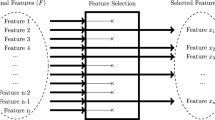Abstract
Gene selection is a common task in microarray data classification. The most commonly used gene selection approaches are based on gene ranking, in which each gene is evaluated individually and assigned a discriminative score reflecting its correlation with the class according to certain criteria, genes are then ranked by their scores and top ranked ones are selected. Various discriminative scores have been proposed, including t-test, S2N,RelifF, Symmetrical Uncertainty andχ 2-statistic. Among these methods, some require abundant data and require the data follow certain distribution, some require discrete data value. In this work, we propose a gene ranking method based on Grey Relational Analysis (GRA) in grey system theory, which requires less data, does not rely on data distribution and is more applicable to numerical data value. We experimentally compare our GRA method with several traditional methods, including Symmetrical Uncertainty, χ 2-statistic and ReliefF. The results show that the performance of our method is comparable with other methods, especially it is much faster than other methods.
Preview
Unable to display preview. Download preview PDF.
Similar content being viewed by others
References
Lu, Y., Han, J.: Cancer classification using gene expression data. Information Systems 28(4), 243–268 (2003)
Golub, T.R., Slonim, D.K., Tamayo, P., et al.: Molecular classification of cancer: Class discovery and class prediction by gene expression monitoring. Science 286(5439), 531–537 (1999)
Cho, S.B., Won, H.H.: Machine learning in DNA microarray analysis for cancer classification. In: Proc. of the First Asia Pacific Bioinformatics Conference, Adelaide, Australia, vol. 19, pp. 189–198. Australian Computer Society (2003)
Bø, T.H., Jonassen, I.: New feature subset selection procedures for classification of expression profiles. Genome Biology, 3(4), research0017.1–0017.11 (2002)
Kononenko, I.: Estimating attributes: analysis and extensions of Relief. In: Bergadano, F., De Raedt, L. (eds.) ECML 1994. LNCS, vol. 784, pp. 171–182. Springer, Heidelberg (1994)
Yu, L., Liu, H.: Redundancy based feature selection for microarray data. In: Proc. of SIGKDD (2004)
Deng, J.: Control systems of grey systems. Systems and Control Letter 5, 288–294 (1982)
Hsieh, C.-H.: Grey image hiding. The Journal of Grey System 3, 275–282 (2000)
Hsu, Y.T.: High noise vehicle plate recognition using grey system. The Journal of Grey System 10, 193–208 (1998)
Ng, D.K.W.: Grey system and grey raltional model. In: ACM SIGICE (October 1994)
Witten, I., Frank, E.: Data Mining – Pracitcal Machine Learning Tools and Techniques with JAVA Implementations. Morgan Kaufmann Publishers, San Francisco (2000)
Armstrong, S.A., et al.: MLL Translocations Specify A Distinct Gene Expression Profile that Distinguishes A Unique Leukemia. Nature Genetics 30, 41–47 (2002)
Rosenwald, A., et al.: The use of molecular profiling to predict survival after chemotherapy for diffuse large-B-cell lymphoma. The New England Journal of Medicine 346(25), 1937–1947 (2002)
Author information
Authors and Affiliations
Editor information
Editors and Affiliations
Rights and permissions
Copyright information
© 2006 Springer-Verlag Berlin Heidelberg
About this paper
Cite this paper
Zhang, LJ., Li, ZJ. (2006). Gene Selection for Classifying Microarray Data Using Grey Relation Analysis. In: Todorovski, L., Lavrač, N., Jantke, K.P. (eds) Discovery Science. DS 2006. Lecture Notes in Computer Science(), vol 4265. Springer, Berlin, Heidelberg. https://doi.org/10.1007/11893318_46
Download citation
DOI: https://doi.org/10.1007/11893318_46
Publisher Name: Springer, Berlin, Heidelberg
Print ISBN: 978-3-540-46491-4
Online ISBN: 978-3-540-46493-8
eBook Packages: Computer ScienceComputer Science (R0)




